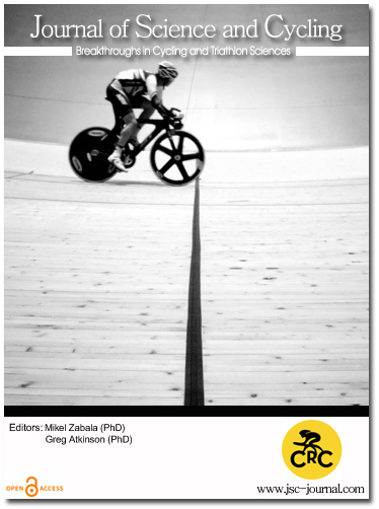Muscle deoxygenation during moderate- and severe-intensity cycling in youth elite-cyclists
Abstract
Background: Near-infrared spectroscopy (NIRS) is a well-established technique to measure tissue oxygenation and haemodynamics during exercise. While muscle oxygen consumption is derived by measuring concentration changes of oxygenated and deoxygenated haemoglobin and myoglobin (O2Hb and HHb), total haemoglobin (tHb = O2Hb + HHb) reflect blood volume and perfusion. In particular, the change in HHb is considered a proxy for oxygen extraction at the muscle level during exercise and arterial occlusion, where the rate of reoxygenation has been used as a measure of mitochondrial function (Ryan et al, 2012: Journal of Applied Physiology, 113, 175-183). NIRS-derived signals therefore reflect the dynamic balance between oxygen delivery and utilisation and may be important measures to monitor training induced adaptations of aerobic function in skeletal muscle. However, current literature is scarce regarding reliability measures, especially in young athletes, which needs to be established to interpret changes with confidence.
Purpose: To assess the test-retest reliability of HHb-changes during moderate- and severe- intensity cycling, and during arterial occlusion in youth elite-cyclists.
Methods: Fifteen cyclist (mean ± SD: age 13.5 ± 1.8 y; stature 163.2 ± 12.2 cm; body mass 51.3 ± 12.4 kg; O2max 62.1 ± 4.2 mL.min-1.kg-1) completed two 6-min rest-to-work transitions (T) from baseline (BL: 60 W) to moderate- (90% of the first ventilatory threshold [VT1]: 120 ± 26 W) and to severe- (50% between VT and maximum power [Delta50]: 204 ± 43 W) intensity cycling. The transitions were interspersed by 8 min BL cycling. After Delta50 cycling, an occlusion was applied on the proximal thigh at a pressure of 300 mmHG until a levelling-off of the HHb signal was observed (3-5 min). The protocol was repeated after a passive rest of 1 h. Changes in HHb were measured on the belly of the right vastus lateralis muscle with a portable continuous-wave NIRS device at a sampling rate of 5 Hz (PortaMon, Artinis). Second-per-second data, were corrected for blood volume changes and normalised to the full functional range measured during the occlusion (0-100%). HHb changes (%) were calculated from BL to the maximum of VT1 (ΔBL-VT1) and from BL to the maximum of Delta50 (ΔBL-Delta50). In addition, the reoxygenation after occlusion was assessed with the slope of linear regression analysis (%.s-1). A typical example of the HHb signal is shown in Figure 1. Absolute and relative reliability was calculated with Bland-Altman statistics ± 95% limits of agreement and the coefficient of variation (CV; %), respectively. Paired t-tests were used for comparisons.
Results: The ΔBL-VT1 was 20.5 ± 11.7 and 21.6 ± 12.3% during T1 and T2, respectively (p = 0.079). The bias was 1.1 ± 2.3 % (95% LoA: -5.6 – 3.3) and the CV 10.1% (7.3 – 16.4). The ΔBL-Delta50 were 58.1 ± 9.6 (T1) and 56.5 ± 9.3% (T2) (p = 0.133) and the bias and CV were 1.6 ± 3.9% (-6.0 – 9.3) and 5.4% (3.9 – 8.6), respectively. The reoxygenation slopes were 7.2 ± 2.0 (T1) and 7.6 ± 2.1 %.s-1 (T2) (p = 0.053) with a bias and CV of 0.4 ± 0.7 %.s-1 (-1.8 – 1.0) and 7.0% (5.1 – 11.2), respectively.
Discussion: The present study quantified reliability for NIRS-derived changes in HHb during cycling at moderate and severe intensity as well as for reoxygenation after occlusion. The provided levels of 5.4% for severe-intensity cycling and 7.0% for the reoxygenation slope, are well below the level of 10% considered as acceptable for a measurement, and the level of 10.1% for moderate-intensity cycling is only marginally higher. The reliability data established, provide limits within which training induced adaptations may be interpreted with confidence. Longitudinal studies in young athletes could potentially benefit from these findings since the magnitude of changes in NIRS variables is probably greater than the reported measurement error.Downloads
Published
How to Cite
Issue
Section
Copyright (c) 2020 Journal of Science and Cycling

This work is licensed under a Creative Commons Attribution-NonCommercial 4.0 International License.
Authors contributing to Journal of Science and Cycling agree to publish their articles under a Creative Commons CC BY-NC-ND license, allowing third parties to copy and redistribute the material in any medium or format, and to remix, transform, and build upon the material, for any purpose, even commercially, under the condition that appropriate credit is given, that a link to the license is provided, and that you indicate if changes were made. You may do so in any reasonable manner, but not in any way that suggests the licensor endorses you or your use.
Authors retain copyright of their work, with first publication rights granted to Cycling Research Center.






